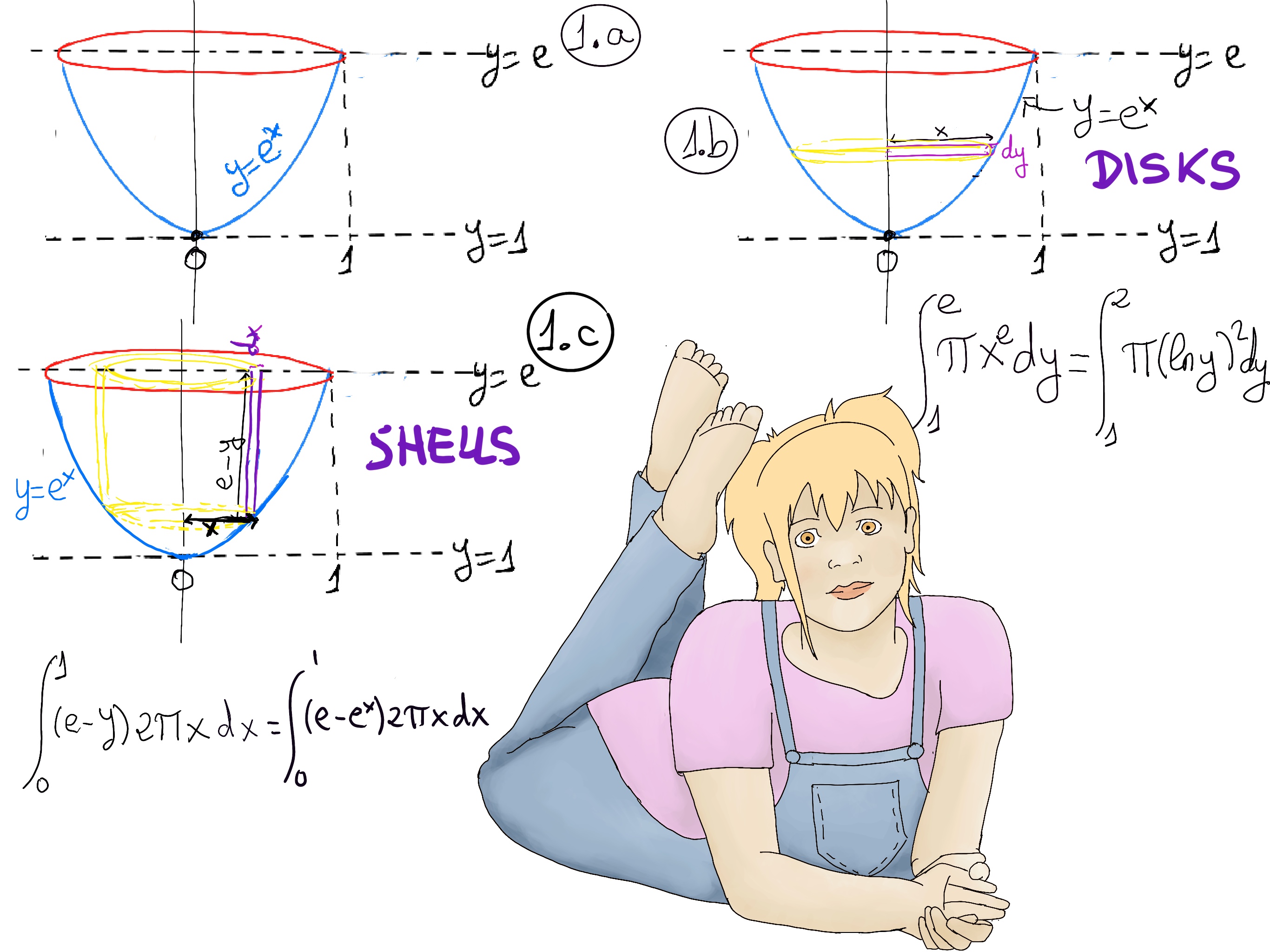
|
 |
 |

|
 |
 |
Winners never quit and quitters never win. Football is like life - it requires perseverance, self-denial, hard work, sacrifice, dedication and respect for authority, Vince Lombardi.
Antiderivatives are fundamental concepts in calculus. They are the inverse operation of derivatives.
Given a function f(x), an antiderivative, also known as indefinite integral, F, is the function that can be differentiated to obtain the original function, that is, F’ = f, e.g., 3x2 -1 is the antiderivative of x3 -x +7 because $\frac{d}{dx} (x^3-x+7) = 3x^2 -1$. Symbolically, we write F(x) = $\int f(x)dx$.
The process of finding antiderivatives is called integration.
The Fundamental Theorem of Calculus states roughly that the integral of a function f over an interval is equal to the change of any antiderivate F (F'(x) = f(x)) between the ends of the interval, i.e., $\int_{a}^{b} f(x)dx = F(b)-F(a)=F(x) \bigg|_{a}^{b}$
It is a technique used in calculus to evaluate integrals of the form $\int uv’dx$. Recall that (uv)’ = u’v + uv’ ⇒ uv’ = (uv)’ -u’v ⇒ $\int uv’dx = uv -\int u’vdx$, e.g., $\int lnx dx =$[u = lnx, u’ = 1/x, v = x, v’ = 1] xlnx -$\int \frac{1}{x}xdx = xlnx -x + C.$ 🚀

$\int \frac{ln(x)}{x^2}dx$ =[Integration by parts, ∫udv = uv - ∫vdu. u = ln(x), v’ =1/x2, u’ = dx/x, v =-1/x] $ln(x)·\frac{-1}{x}-\int \frac{dx}{x}\frac{-1}{x} = \frac{-ln(x)}{x}+\int \frac{dx}{x^2} = \frac{-ln(x)}{x} -\frac{1}{x} + C = -\frac{ln(x)+1}{x}+C.$
$\int xsec^2(x)dx =$ [Integration by parts, ∫udv = uv - ∫vdu. u = x, v’ = sec2(x)dx, u’ = dx, v = tan(x). Integration formulas for trigonometry] x·tan(x) - $\int tan(x)dx = xtan(x) -(-ln(|cos(x)|)) + C = xtan(x) +ln|cos(x)| + C.$
$\int e^xsin(x)dx$ =[Integration by parts, ∫udv = uv - ∫vdu. u = sin(x), v’=exdx, u’ = cos(x)dx, v = ex] $e^xsin(x)-\int e^xcos(x)dx$ =[u = cos(x), v’ = exdx, u’ = -sin(x)dx, v = ex] $e^xsin(x)-(e^xcos(x)-\int e^x(-sin(x))) ⇒ \int e^xsin(x)dx = e^xsin(x)-e^xcos(x)-\int e^xsin(x) ⇒ 2\int e^xsin(x)dx = e^xsin(x)-e^xcos(x) ⇒ \int e^xsin(x)dx = \frac{1}{2}e^x(sin(x)-cos(x)) + C.$
$\int_{1}^{4} x^{\frac{1}{2}}ln(2x)dx$ =[Integration by parts, ∫udv = uv - ∫vdu. u = ln(2x), v’=x1/2dx, du = 2⁄2xdx = 1⁄x, v = 2⁄3x3⁄2] $\frac{2}{3}x^{\frac{3}{2}}ln(2x) -\int_{1}^{4} \frac{2}{3}x^{\frac{3}{2}}·\frac{1}{x}dx = \frac{2}{3}x^{\frac{3}{2}}ln(2x) -\frac{2}{3}\int_{1}^{4} x^{\frac{1}{2}}dx =\frac{2}{3}x^{\frac{3}{2}}ln(2x) -\frac{2}{3}\frac{2}{3}x^{\frac{3}{2}} = \frac{2}{3}x^{\frac{3}{2}}ln(2x) -\frac{4}{9}x^{\frac{3}{2}}\bigg|_{1}^{4} = (\frac{2}{3}8ln(8) -\frac{32}{9})-(\frac{2}{3}ln(2) -\frac{4}{9}) = (\frac{2}{3}8ln(2^3) -\frac{32}{9})-(\frac{2}{3}ln(2) -\frac{4}{9}) = (16ln(2) -\frac{32}{9})-(\frac{2}{3}ln(2) -\frac{4}{9}) = 16ln(2) -\frac{32}{9}-\frac{2}{3}ln(2)+\frac{4}{9} = \frac{46}{3}ln(2)-\frac{28}{9} ≈ 7.51$
$\int arcsin(x)dx$ =[Integration by parts, ∫udv = uv - ∫vdu. u = arcsin(x), v’ = dx, u’ = $\frac{1}{\sqrt{1-x^2}}dx$, v = x] $x·arcsin(x)-\int \frac{x}{\sqrt{1-x^2}}dx$ =[U-substitution, u = 1 -x2, du = -2xdx] $x·arcsin(x)+\frac{1}{2}\int \frac{1}{\sqrt{u}}dx = x·arcsin(x)+\frac{1}{2}2\sqrt{u} = x·arcsin(x)+\sqrt{u} = x·arcsin(x)+\sqrt{1-x^2}+C.$
Find the volume of an exponential wineglass, that is, y = ex rotated around the y-axis between y = 1 and y = e.

The obvious answer is -horizontal slicing- $\int_{1}^{e} πx^2dy$ =[y = ex, x = lny] π$\int_{1}^{e} (lny)^2dy = πF_2(y)\bigg|_{1}^{e}$ =
Considering a previous exercise = $π(y(lny)^2-2(ylny -y)) \bigg|_{1}^{e} = π(e·1^2)- 2π(e·1-e) -π(1·0^2-2(1·0-1))= πe -0 -2π= π(e-2)$.
Analogously, the answer is -vertical slicing- $\int_{0}^{1} (e-y)2πxdx = \int_{0}^{1} (e-e^x)2πxdx = \int_{0}^{1}2πexdx -2π\int_{0}^{1} xe^xdx $=[A previous exercise]$ 2πe\frac{x^2}{2} -2πxe^x +2πe^x\bigg|_{0}^{1} = 2πe\frac{1}{2}-2πe+2πe-2π = πe -2π = π(e-2).$
$\int xtan^{-1}(x)dx$ =[v’=xdx, u = tan-1x, u’ = 1⁄1+x², v = x²/2] = $\frac{x^2}{2}tan^{-1}(x) - \int \frac{x^2}{2}\frac{1}{1+x^2}dx = \frac{x^2}{2}tan^{-1}(x) - \frac{1}{2}\int \frac{x^2}{1+x^2}dx$ = [x²⁄1+x² = x²+1-1⁄1+x² = 1-1⁄1+x² ] = $\frac{x^2}{2}tan^{-1}(x)-\frac{1}{2}x+\frac{1}{2}tan^{-1}x + C.$
$\int x^3ln(x)dx =$[u = ln(x), v’= x3dx, u’ = 1⁄xdx, v = x4⁄4] $ln(x)\frac{x^4}{4}-\int \frac{x^4}{4}\frac{1}{x}dx = ln(x)\frac{x^4}{4}-\frac{1}{4}\int x^3dx = ln(x)\frac{x^4}{4}-\frac{1}{4}\frac{x^4}{4}+C = \frac{1}{4}(x^4ln(x)-\frac{x^4}{4})+C.$
Prove that $\int_{0}^{∞} x^ne^{-x}dx = n!$ for all n ≥ 0.
Case base, n = 0, $\int_{0}^{∞} x^ne^{-x}dx = \int_{0}^{∞} e^{-x}dx = \lim_{t \to ∞} -e^{-x}\bigg|_{0}^{t} =$
$\lim_{t \to ∞} (-\frac{1}{e^t}+1) = 1 = 0!.$
Induction hypothesis, for k ≥ 0, the equality holds, $\int_{0}^{∞} x^ke^{-x}dx = k!$
Let’s consider $\int_{0}^{∞} x^{k+1}e^{-x}dx$ =[u = xk+1, du = (k+1)xkdx, dv = e-xdx, v = -e-x] = [1] + [2]
[1] $-x^{k+1}e^{-x}\bigg|_{0}^{∞} = 0 -0 = 0$. And the key is to understand that the exponent term e-x goes to zero much faster than any power of x grows to infinity.
Another way of seeing it, $\lim_{x \to ∞} \frac{x^k}{e^{x}} =$[L’Hôpital’s rule] $\lim_{x \to ∞} \frac{kx^{k-1}}{e^{x}} = \lim_{x \to ∞} \frac{k(k-1)x^{k-2}}{e^{x}} = ··· = \lim_{x \to ∞} \frac{some~constant}{e^{x}} = 0$
[2] $+ (k+1)\int_{0}^{∞} x^ke^{-x}dx = $[Induction hypothesis, for k ≥ 0, the equality holds, $\int_{0}^{∞} x^ke^{-x}dx = k!$] (k+1)k! = (k+1)!, hence $\int_{0}^{∞} x^ne^{-x}dx = n!$